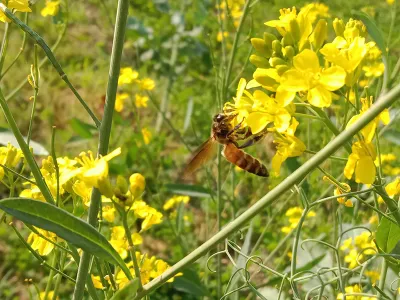Summary
Ortoambiente is an Italian Operational Group which developed agroecological pest protection strategies for high-density horticultural crops. Through the implementation of functional biodiversity at farm level, for example planting flower strips and trap crops, the project was able to control insect pests whilst maintaining a high level of environmental sustainability.
Ortoambiente is an Italian Operational Group which developed agroecological pest protection strategies for high-density horticultural crops. Through the implementation of functional biodiversity at farm level, for example planting flower strips and trap crops, the project was able to control insect pests whilst maintaining a high level of environmental sustainability.
Gianfranco Fornari represents the farmers’ organisation Agribologna, one of the project partners. He explains that the development of sustainable techniques in horticulture is becoming more and more important: “We have to respond to a market that is increasingly looking for healthier products and products grown in a way that is more respectful to the environment. At the same time, chemistry is no longer an answer, legal regulations are restricting many chemical pesticides, and harmful insects are more and more aggressive, and more and more resistant to chemical molecules.”
Ortoambiente, led by Centro Agricoltura e Ambiente Giorgio Nicoli, therefore set out to implement, test, and share agroecological techniques to help protect crops such as lettuce, cauliflower, cabbage, and courgette against attacks by the main harmful insects in the region of Bologna. The aim was to increase the presence of beneficial insects and pollinators, safeguard the income of farms, and contribute to protecting the environment. All of this with the aim of achieving greater resilience of agroecosystems faced with climate change.
Crop protection techniques were tested on five farms. One of the techniques was planting grass and flower strips alongside cash crops. The partners selected plant species which can improve the action of natural enemies of pests and support biological control, such as buckwheat, vetch, and coriander. These tests proved effective against aphids on lettuce. Flowering strips showed an abundance of natural enemies, highlighting the importance of this ecological infrastructure. Providing these habitats on the farm level also meant that refuge areas continued to encourage beneficial insects and pollinators to remain nearby, even during unfavourable periods. This technique was also combined with the application of agro-textile fabric mulch. The partners found this was effective in protecting cauliflower against flea beetles. Approximately one month before harvest - once the risk of flea beetle attacks has passed - the mulch must be removed in the evening to avoid the crops being affected by the thermal shock caused by high daytime temperatures.
Another technique was to plant species such as mustard and rocket as trap crops, to attract harmful insects and therefore prevent or delay them from reaching the horticultural crops. Outcomes showed that sowing the trap plants with a margin of about ten metres from the main crop is the most effective.
Pheromone traps were also added to the test sites, alongside the other techniques. This significantly supported the efficacy of biological control of aphids on lettuce. Roberto Ferrari from the Centro Agricoltura e Ambiente Giorgio Nicoli says “The pheromone traps we used allowed the farmer to reduce the damage to lettuce from a minimum of 30% as we found in 2021 up to a maximum of 50% as we saw the previous year.”
Through their analyses, the Operational Group found that the management of the ecological infrastructures not only supported biological control of pests but also increased the numbers of beneficial insects and pollinators, reduced the use of inputs and water resources, and produced healthier, higher-quality consumer products. Gianfranco Fornari adds “These techniques provide organic substances to the soil […]. They bring further savings because if I enrich my land and make it more fertile, this also allows me to use even less chemical fertiliser, and increases the soil’s water retention capacity in case of drought.”
Sources for the article:
Contact Information
Project contact: caa.srl@pec.it

